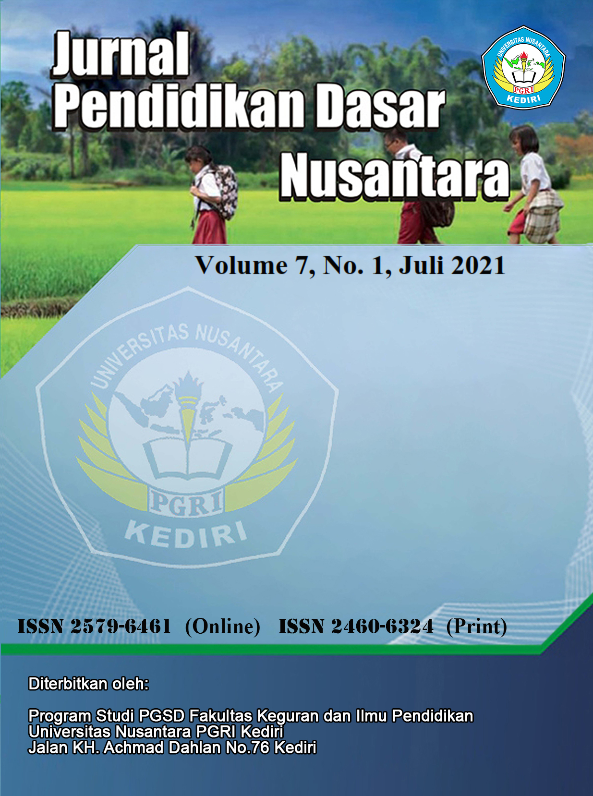Efektivitas Penggunaan Model Pembelajaran Probing-Prompting Terhadap Hasil Belajar Siswa Tema Lingkungan Sahabat Kita di Kelas V Sekolah Dasar
DOI:
https://doi.org/10.29407/jpdn.v7i1.15963Keywords:
learning model, probing-prompting model, learning outcomes.Abstract
This study aims to determine the effectiveness of the use of the probing-prompting learning model on student learning outcomes on the theme Our Friends of the Environment in grade V Elementary School. This study uses a quantitative method with a quasy experimental research type. Population and sample of all students in grade V with a total of 17 students. The data obtained by observation, pretest (pre-test) aims to determine student learning outcomes before being given treatment and posttest (final test) to determine student learning outcomes after being given treatment. The research instrument used the pretest and posttest questions. Data analysis using t-test, t-test results on learning outcomes obtained t count> t table that is 3.29> 2.09 with a confidence level of 95%. Meanwhile, the influence of variable X (probing-prompting learning model) on variable Y (learning outcomes) is 76.7%. With these results, the alternative hypothesis is accepted and the null hypothesis is rejected. It can be concluded that there is a significant effect of the probing-prompting learning model on student learning outcomes in the theme of our best friend's environment in grade V elementary school.
Downloads
References
Abdurokhim, Mohamad. 2015. Keefektifan Model Probing-Prompting Dalam Pembelajaran Sejarah Uang Pada Siswa Kelas III Sd Negeri Kepandean 3 Kabupaten Tegal. Skripsi. Fakultas Ilmu Penididkan, Pendidikan Guru Sekolah Dasar, UNNES, Semarang. diakses 22 Maret 2021.
Arikunto, Suharsimi. 2013. Prosedur Penelitian Suatu Pendekatan Praktik. Jakarta: Rineka Cipta.
Artawan, Ketut Agus., Gading, I Ketut., Dibia, I Ketut. 2017. Pengaruh Model Pembelajaran Probing - Prompting Terhadap Hasil Belajar IPA Pada Siswa Kelas V Sekolah Dasar. UNDIKSHA: JJPGSD, 5(2), 1-10. doi: http://dx.doi.org/10.23887/jjpgsd.v5i2.10916.
Dimyati & Mudjiono. 2015. Belajar dan Pembelajaran. Jakarta: Rineka Cipta.
Firosalia, Kristin. 2016. Analisis Model Pembelajaran Discovery Learning Dalam Meningkatkan Hasil Belajar Siswa SD. Jurnal Pendidikan Dasar PerKhasa: Jurnal Penelitian Pendidikan Dasar , 2(1), 90-98. diakses 22 Maret 2021.
Hamdu, Ghullam., Agustina, Lisa. 2012. Pengaruh Motivasi Belajar Siswa Terhadap Pestasi Belajar Ipa Di Sekolah Dasar. Universitas Pendidikan Indonesia: Jurnal Penelitian Pendidikan, 11(1), 36-47, diakses 22 Maret 2021.
Hendrawan, Teguh., Kasdi, Aminuddin., Sukartiningsih, Wahyu. 2019. Pengaruh Model Pembelajaran Probing-Prompting Terhadap Hasil Belajar Siswa Di Kelas V Sekolah Dasar. Jurnal Review Pendidikan Dasar: Jurnal Kajian Penelitian dan Hasil Penelitian, 5(3), 24-33. doi: http://dx.doi.org/10.26740/jrpd.v5n3.p1084-1091.
Huda, Miftahul. 2013. Model-model Pengajaran dan Pembelajaran. Yogyakarta: Pustaka Pelajar.
Kusuma, Yanti Yandri. 2020. Penerapan Model Pembelajaran Probingpromting Untuk Meningkatkan Aktivitas Belajar Pada Mata Pelajaran Pkn Di Sekolah Dasar. Universitas Pahlawan: Jurnal Review Pendidikan dan Pengajaran, 3(1),34-42, diakses 22 Maret 2021.
Soentoro, Ali Idris. 2015. Cara Mudah Belajar Metodologi Penelitian Dengan Aplikasi Statistika: Edisi Pertama, Depok: PT Taramedia Bakti Persada.
Sugiyono. 2015. Metode Penelitian Pendidikan Pendekatan Kuantitatif, Kualitatif, dan R & D. Bandung : Alfabeta.
Supriyadi. 2011. Strategi Belajar Mengajar. Yogyakarta: Cakrawala Ilmu.
Susanto. Ahmad. 2014. Pengembangan Pembelajaran IPS di Sekolah Dasar. Jakarta: Prenada Media Group.
Thobroni. 2015. Belajar dan Pembelajaran:Teori dan Praktik. Yogyakarta: Ar-Ruz Media.
Trianto. 2011. Model Pembelajaran Terpadu. Jakarta: Bumi Aksara.
Downloads
Published
Issue
Section
License
Authors who publish with this journal agree to the following terms:
- Copyright on any article is retained by the author(s).
- The author grants the journal, the right of first publication with the work simultaneously licensed under a Creative Commons Attribution License that allows others to share the work with an acknowledgment of the work’s authorship and initial publication in this journal.
- Authors are able to enter into separate, additional contractual arrangements for the non-exclusive distribution of the journal’s published version of the work (e.g., post it to an institutional repository or publish it in a book), with an acknowledgment of its initial publication in this journal.
- Authors are permitted and encouraged to post their work online (e.g., in institutional repositories or on their website) prior to and during the submission process, as it can lead to productive exchanges, as well as earlier and greater citation of published work.
- The article and any associated published material is distributed under the Creative Commons Attribution-ShareAlike 4.0 International License
































